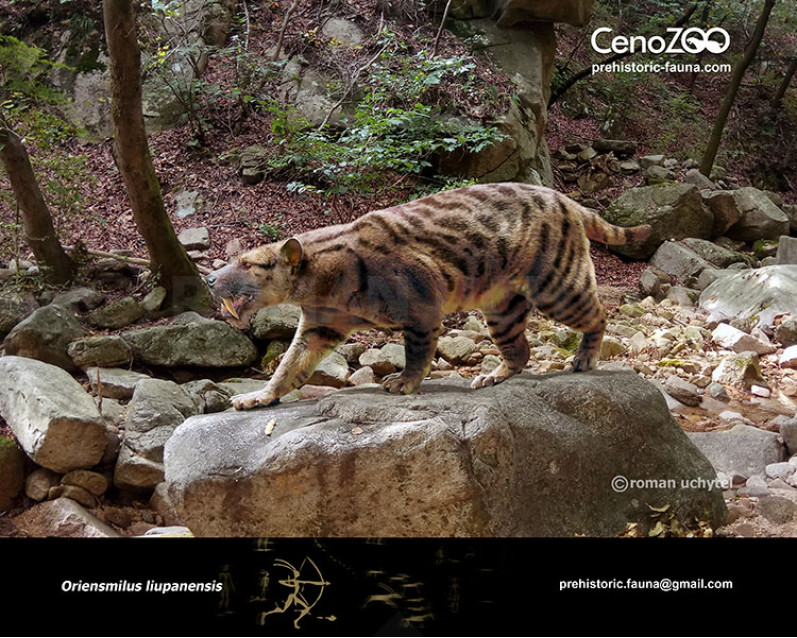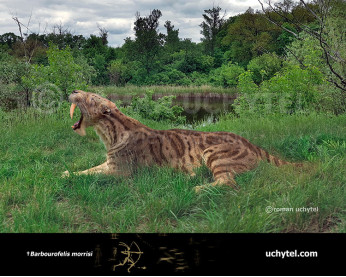Oriensmilus liupanensis
24502450
A new genus and species of sabretooth, Oriensmilus liupanensis (Barbourofelinae, Nimravidae, Carnivora), from the middle Miocene of China suggests barbourofelines are nimravids, not felids
Since the early 2000s, a revival of a felid relationship for barbourofeline sabretooths has become popular due to recent discoveries of fragmentary fossils from Africa. According to this view, barbourofelines trace their common ancestor with felids through shared similarities in dental morphology going back to the early Miocene of Africa and Europe. However, whether or not such an idea is represented in the basicranial morphology, a conservative area of high importance in family-level relationships, is yet to be tested. A nearly complete skull of Oriensmilus liupanensis gen. and sp. nov. from the middle Miocene Tongxin Basin of northern China represents the most primitive known barbourofeline with an intact basicranial region, affording an opportunity to re-examine the relationship of felids and nimravines. We also present an update on East Asian records of barbourofelines. The new skull of Oriensmilus possesses a suite of characters shared with nimravines, such as the lack of an ossified (entotympanic) bullar floor, absence of an intrabullar septum, lack of a ventral promontorial process of the petrosal, presence of a small rostral entotympanic on the dorsal side of the caudal entotympanic, and a distinct caudal entry of the internal carotid artery and nerve that pierces the caudal entotympanic at the junction of the ossified and unossified caudal entotympanics. The absence of an ossified bullar floor in O. liupanensis and its presence in those from the middle Miocene of Sansan, France thus help to bracket the transition of this character, which must have happened in the early part of the middle Miocene. Spatial relationships between bullar construction and the middle ear configuration of the carotid artery in Oriensmilus strongly resemble those in nimravines but are distinctly different from felids and other basal feliforms. Despite the attractive notion that early barbourofelines arose from a Miocene ancestor that also gave rise to felids, the basicranial evidence argues against this view.
Xiaoming Wang, Stuart C. White & Jian Guan (2020): A new genus and species of sabretooth, Oriensmilus liupanensis (Barbourofelinae, Nimravidae, Carnivora), from the middle Miocene of China suggests barbourofelines are nimravids, not felids , Journal of Systematic Palaeontology, DOI: 10.1080/14772019.2019.1691066
https://doi.org/10.1080/14772019.2019.1691066
Payment
You may use multiple payment methods to buy image such as credit cards, PayPal and bank transfer.
A new genus and species of sabretooth, Oriensmilus liupanensis (Barbourofelinae, Nimravidae, Carnivora), from the middle Miocene of China suggests barbourofelines are nimravids, not felids
Since the early 2000s, a revival of a felid relationship for barbourofeline sabretooths has become popular due to recent discoveries of fragmentary fossils from Africa. According to this view, barbourofelines trace their common ancestor with felids through shared similarities in dental morphology going back to the early Miocene of Africa and Europe. However, whether or not such an idea is represented in the basicranial morphology, a conservative area of high importance in family-level relationships, is yet to be tested. A nearly complete skull of Oriensmilus liupanensis gen. and sp. nov. from the middle Miocene Tongxin Basin of northern China represents the most primitive known barbourofeline with an intact basicranial region, affording an opportunity to re-examine the relationship of felids and nimravines. We also present an update on East Asian records of barbourofelines. The new skull of Oriensmilus possesses a suite of characters shared with nimravines, such as the lack of an ossified (entotympanic) bullar floor, absence of an intrabullar septum, lack of a ventral promontorial process of the petrosal, presence of a small rostral entotympanic on the dorsal side of the caudal entotympanic, and a distinct caudal entry of the internal carotid artery and nerve that pierces the caudal entotympanic at the junction of the ossified and unossified caudal entotympanics. The absence of an ossified bullar floor in O. liupanensis and its presence in those from the middle Miocene of Sansan, France thus help to bracket the transition of this character, which must have happened in the early part of the middle Miocene. Spatial relationships between bullar construction and the middle ear configuration of the carotid artery in Oriensmilus strongly resemble those in nimravines but are distinctly different from felids and other basal feliforms. Despite the attractive notion that early barbourofelines arose from a Miocene ancestor that also gave rise to felids, the basicranial evidence argues against this view.
Xiaoming Wang, Stuart C. White & Jian Guan (2020): A new genus and species of sabretooth, Oriensmilus liupanensis (Barbourofelinae, Nimravidae, Carnivora), from the middle Miocene of China suggests barbourofelines are nimravids, not felids , Journal of Systematic Palaeontology, DOI: 10.1080/14772019.2019.1691066
https://doi.org/10.1080/14772019.2019.1691066



-346x277.jpg)
1-346x277.jpg)